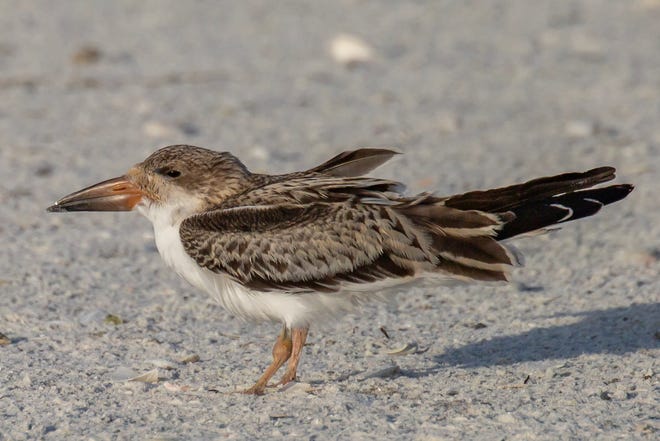Unknown illness kills 'unusual' number of Marco Island seabirds
 Karl Schneider
Karl SchneiderOn the north end of Marco Island, near a stretch of beach locals call Sand Dollar Island, residents this summer noticed a strange sickness afflicting a local seabird colony.
Young black skimmers, a state-protected species, were seen limping and dying in alarming numbers in the state's Big Marco Pass critical wildlife area.
"This summer, a number of chicks started hobbling like they had arthritis and some died," Marco resident Andrew Tyler said. "These were primarily juveniles."

Wildlife officials with the Florida Fish and Wildlife Conservation Commission have confirmed there has been an unusual number of sick and dying skimmers.
"The birds displayed swollen leg joints and lameness," FWC spokeswoman Michelle Kerr wrote in an email. "Full necropsy results are still pending, and once complete, may help with a more accurate interpretation of what caused the illness."
More:Gopher tortoise, skimmer among patients seen by hospital staff
More:This is crucial time of year for two threatened species of shorebirds in Florida
The von Arx Wildlife Hospital in Naples has taken in a mixture of sick shorebirds from Marco, with skimmers and others showing signs of dullness, director Joanna Fitzgerald said.
“There were overlapping symptoms: some not doing well and not able to stand,” she said.
Fitzgerald said her hospital has sent about 22 specimens to FWC for testing. A few of the birds vox Arx received were in rough shape and didn’t make it through the next 24 – 48 hours, she said. Some came in dead-on-arrival.

Black skimmers are protected, state threatened birds under Florida’s Endangered and Threatened Species Rule.
“The black skimmer faces many threats as the human population increases and spreads to previously undeveloped coasts,” FWC’s website says. “Habitat loss due to coastal development is the main threat to the species.”
Skimmers are named for the species’ unique feeding technique. The shorebirds will fly low and skim the water’s surface with their lower bill. The birds generally nest in colonies along beaches.
The FWC continues to communicate with wildlife veterinarians at local wildlife rehabilitation facilities and has received additional seabird and shorebird carcasses for necropsy as part of this investigation, Kerr wrote.
The Clinic for the Rehabilitation of Wildlife (CROW) on Sanibel confirmed it received two sick skimmers from Marco in mid-August.
CROW and FWC did not provide a diagnosis, but specimens have been sent to the Southeastern Cooperative Wildlife Disease Study for further investigation.
That group is a research and service organization at the University of Georgia's College of Veterinary Medicine. The university did not respond to inquiries.
"The problem is the event is over. Birds are dead or they survived and everybody’s moved on," said Brad Cornell of the Audubon of the Western Everglades. "Nobody wants it to happen again, so trying to figure out what caused it, is it still there and what do we do about it, is important."
More:Watch out: Tiny shoreline chicks are growing up on some Southwest Florida beaches this summer
Karl Schneider is an environment reporter. Connect with him via email at kschneider@gannett.com and on Twitter: @karlstartswithk